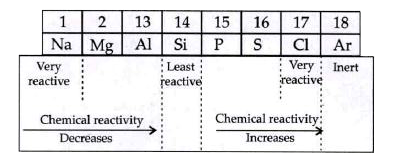Taking an example of element of 3rd period discuss the trend of reactivity from left to right.

Sodium has one electron in its valence shell, which can be donated most easily. Thus, Na is most reactive. Magnesium has 2 electrons in its valence shell, which it donates easily but comparatively with more difficulty than sodium hence, Mg is less reactive than Na and Al is less reactive than Mg. Silicon has 4 electrons in its valence shell. It is difficult for Si to donate or accept 4 electrons, hence, it is least reactive. Phosphorus, sulphur and chlorine have 5, 6 and 7 valence electrons respectively. They accept 3, 2 and 1 electrons respectively. It is easier to accept 1 electron than 2 or 2 electrons than 3. Hence, phosphorus is least reactive followed by sulphur and chlorine which is most reactive. Argon has 8 electrons in its valence shell hence it is chemically inert.
Topper's Solved these Questions
- PERIODIC CLASSIFICATION OF ELEMENTSBOOK - MTG IIT JEE FOUNDATIONCHAPTER - PERIODIC CLASSIFICATION OF ELEMENTSEXERCISE - Exercise (Integer/Numerical Value Type)
5 Videos
- PERIODIC CLASSIFICATION OF ELEMENTSBOOK - MTG IIT JEE FOUNDATIONCHAPTER - PERIODIC CLASSIFICATION OF ELEMENTSEXERCISE - Olympiad/HOTS Corner
15 Videos
- PERIODIC CLASSIFICATION OF ELEMENTSBOOK - MTG IIT JEE FOUNDATIONCHAPTER - PERIODIC CLASSIFICATION OF ELEMENTSEXERCISE - Exercise (Subjective Problems) (Short Answer Type)
23 Videos
- MOLE CONCEPT, STOICHIOMETRY AND BEHAVIOUR OF GASES BOOK - MTG IIT JEE FOUNDATIONCHAPTER - MOLE CONCEPT, STOICHIOMETRY AND BEHAVIOUR OF GASES EXERCISE - EXERCISE (INTEGER/NUMERICAL VALUE TYPE)
5 Videos
Similar Questions
Rewrite the folowing statements after correction if necessary:
(i) Elements in the same period have equal valency
(ii) The metallic character of elements in a period increases gradually on moving from left to right.
View SolutionDiscuss the trends in chemical reactivity of group 15 elements.
View Solution
Knowledge Check
All element in 3rd period have
AAn atomic number 3B3 complete sub-shellsCValence electrons shellD3 electrons less than the octetThe maximum number of elements in 3rd period is :
A8B18C32Dbetween 8 and 18The least reactive elements of the periodic table are:
ATransition elementsBInner transition elementsCAlkali metalsDNoble gases
The elements of a period of the periodic table are given below in order from left to right with one of its element missing:
Na Mg Al Si S Cl Ar .
(a) To which period do these elements belong? (b) One element of this period is missing. Which is the missing element and where should it be placed? (c) Which one of these elements in this period shows the property of catenation? (d) Which one of these elements is least reactive? (e) Identify the halogen from this period.
View SolutionHow does ionisation enthalpy of the elements very as we move across the period from left to right ?
View SolutionIn a period of the periodic table as we move from left to right usually
View SolutionElectronegativity ______ from left to right in a row in the periodic table and electro positivity ______ from left to right in a row in the periodic table
View SolutionWhich of the following statements is not a correct statement about the trends when going from left to right across the periods of periodic Table.
View Solution
